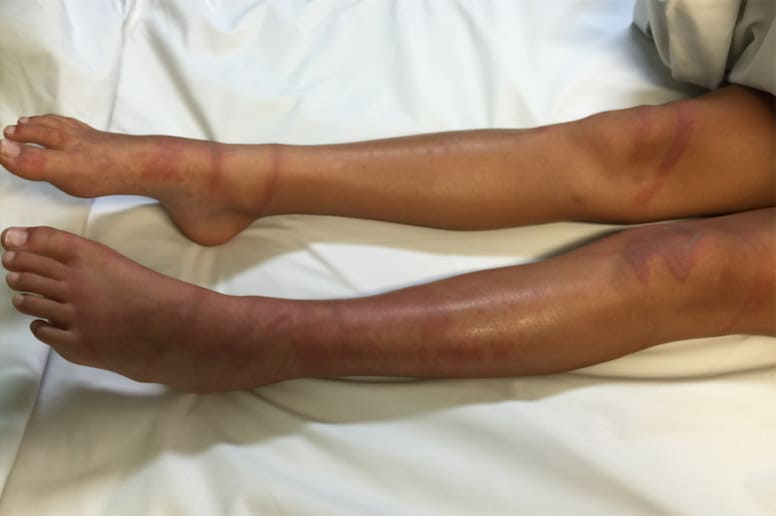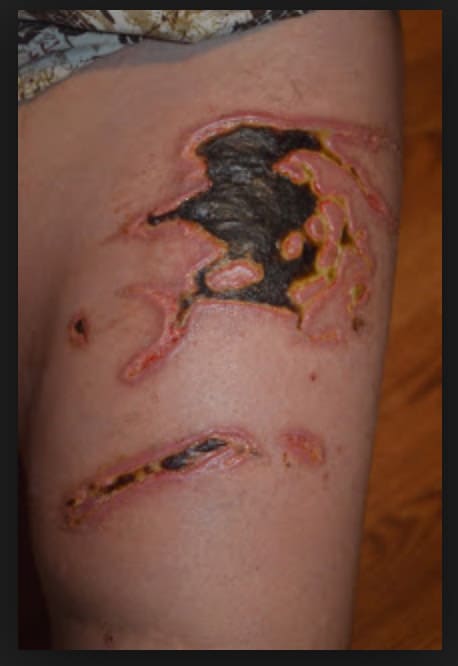The call came: a case of Box Jellyfish(Chironex fleckeri) envenomation in a young girl and her father. The father was stable and pain was under control, however the daughter had such significant pain that, anti-venom had to be used. The wound had been washed with vinegar. Both patients were stable and comfortable in terms of pain levels. Good job by the ambos.
I thought it would be a good time to review. How do we treat these types of stings and are there any controversies?
 The Box Jellyfish is found in Australia’s tropical waters over the summer months. Swimmers may not see it. In fact, the first indication of a sting, may be sudden severe pain. The skin findings are characteristic: there is a band like appearance from each tentacle and a ladder pattern, from the multiple tentacles.
The Box Jellyfish is found in Australia’s tropical waters over the summer months. Swimmers may not see it. In fact, the first indication of a sting, may be sudden severe pain. The skin findings are characteristic: there is a band like appearance from each tentacle and a ladder pattern, from the multiple tentacles.
The venom, which contains a cardiotoxic and dermatonecrotic component, is contained in nematocysts, which fire on contact. Not all nematocysts fire. The aim of initial treatment is to remove the nematocysts, especially those that have not fired, to minimise the chance of further envenomation.
Treatment
Initial treatment involves using vinegar on the affected area and then removing the tentacles, which can be pulled off or scraped off. If vinegar is not available, the limb should be washed in sea water and the tentacles removed. Fresh water should not be used, as this can cause nematocysts to fire.
the controversy with vinegar:
The Australian Resuscitation Council recommends vinegar as an initial treatment:
“Vinegar (4-6% acetic acid) inhibits nematocyst discharge of Box jellyfish 10 but does not provide pain relief from the venom already injected.”
In a recent study by Welfare P et al., (An in-vitro examination of the effect of vinegar on discharged nematocysts of Chironex fleckeri. Diving and Hyperbaric Medicine Volume 44 No. 1 March 2014, pp30-34), it was found that although vinegar has the effect of stopping nematocysts firing, it also causes those that have already fired to produce more venom, increasing venom load by up to 50%.
We know that stings to greater than 10% body surface area can lead to mortality by rapid onset (5-10 minutes) of cardiorespiratory arrest. Producing more venom from already fired nematocysts, on the body, could make things worst very quickly.
The current stand on this is that vinegar is still to be used as this was an in-vitro study. Perhaps more will come with the new resuscitation guidelines later this year.
when do we use antivenom?
Currently anti-venom can be used in 3 situations:
- For pain that cannot be controlled with analgesia
- For arrhythmias
- In cardiac arrest
Anti-venom is given IV or IM. The IV preparation is diluted to 1 in 10(with normal saline) and given as a slow push. Usually one ampule is adequate for severe pain and between three and six ampules are needed for cardiac arrest. In cardiac arrest undiluted anti-venom can be used.
is there a role for magnesium?
Magnesium is recommended for control of pain, however its main use seems to be in the unstable patient that may not be responding to anti-venom.






